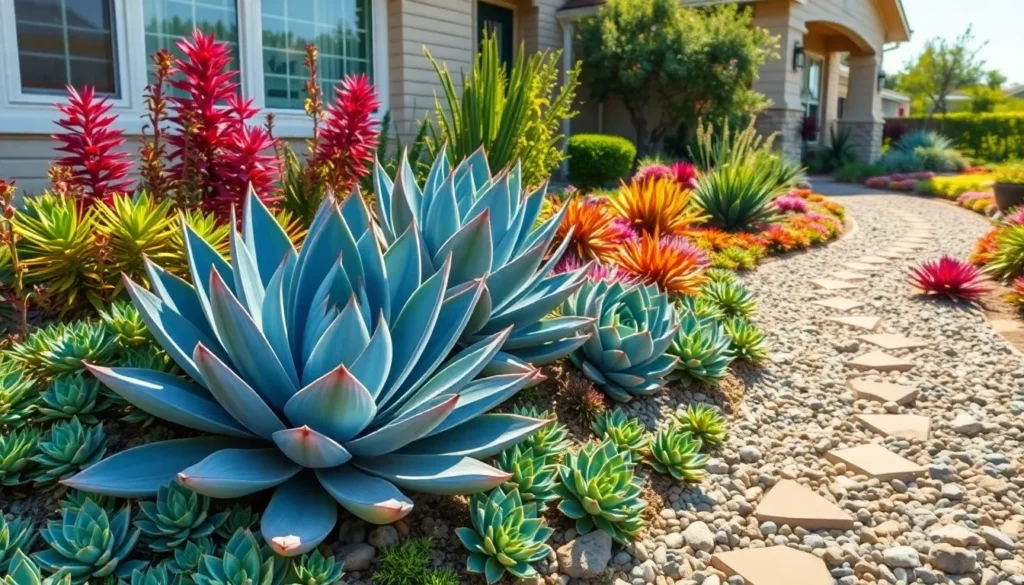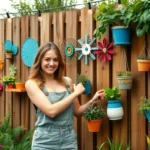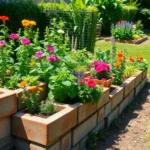Front yards deserve more than just grass and traditional landscaping. We’ve discovered that succulent gardens transform ordinary spaces into stunning drought-resistant showcases that’ll make neighbors stop and stare. These low-maintenance beauties offer endless design possibilities while saving water and reducing yard work.
Succulents aren’t just trendy houseplants anymore – they’re revolutionizing outdoor landscaping. From vibrant Echeveria rosettes to architectural Agave specimens we can create eye-catching displays that thrive in various climates. Whether you’re dealing with poor soil sandy conditions or simply want a garden that practically takes care of itself succulents deliver both beauty and practicality.
We’ll explore creative arrangements that maximize curb appeal while minimizing maintenance. You’ll discover how to combine different textures colors and heights to create a front yard that’s both water-wise and visually striking. Ready to transform your entrance into a desert oasis that impresses year-round?
Create a Desert Oasis with Large Agave Centerpieces
Transform your front yard into a stunning desert industry by anchoring your design with dramatic agave specimens. These architectural plants create instant focal points that command attention while requiring minimal water and maintenance.
Choose Statement Agave Varieties for Maximum Impact
Century plants (Agave americana) deliver the most dramatic presence in front yard succulent gardens with their massive 6-8 foot spread. We recommend positioning these giants as solo centerpieces since their sheer size creates natural boundaries between different garden zones.
Blue agave (Agave tequilana) offers striking silvery-blue foliage that catches sunlight beautifully throughout the day. Plant these medium-sized varieties in groups of three for maximum visual impact without overwhelming smaller garden spaces.
Queen Victoria agave (Agave victoriae-reginae) provides compact elegance with distinctive white markings along each leaf edge. These slower-growing specimens work perfectly for smaller front yards where space is limited but dramatic texture is still desired.
Artichoke agave (Agave parryi var. truncata) creates stunning rosettes with thick, paddle-shaped leaves that maintain perfect symmetry. We’ve found these varieties particularly effective when planted in raised beds or containers to elevate their architectural form.
Design Around Architectural Plant Forms
Symmetrical placement enhances the natural geometry of agave rosettes by positioning them at key focal points like entrance pathways or driveway corners. Create visual balance by placing matching varieties on either side of your front door or walkway.
Layered heights add depth to your desert oasis by combining tall century plants with medium-sized blue agaves and compact queen victoria specimens. Position the largest agaves toward the back of beds with progressively smaller varieties moving forward.
Complementary textures amplify agave architecture when you surround spiky specimens with softer succulents like jade plants or barrel cacti. This contrast makes the rigid agave forms appear even more dramatic and sculptural.
Strategic lighting transforms agave centerpieces into nighttime showstoppers with well-placed uplights that emphasize their striking silhouettes. Solar-powered spotlights positioned at the base of each plant create stunning shadow patterns on nearby walls or fencing.
Design Colorful Succulent Borders Along Walkways
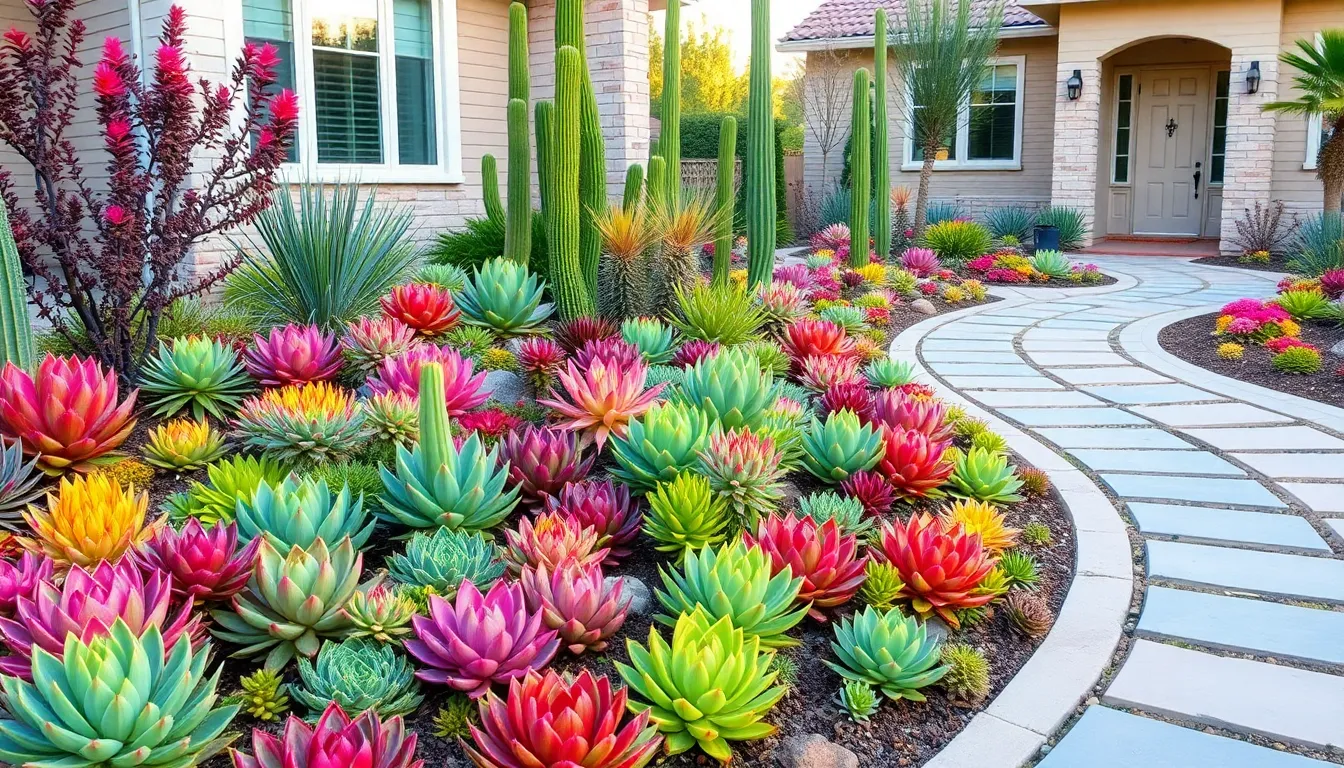
Moving from dramatic centerpiece arrangements to practical pathway designs, we’ll explore how colorful succulent borders can guide visitors while adding visual interest to your front yard. These living edges create stunning first impressions that require minimal maintenance throughout the seasons.
Select Vibrant Echeveria and Sedum Varieties
Choose Echeveria varieties that showcase stunning rosette formations in bold colors like the deep purple ‘Black Prince’ and silvery pink ‘Perle von Nurnberg’. These compact succulents maintain their vibrant hues year round and create perfect uniform spacing along walkway edges.
Incorporate Sedum species that offer contrasting textures and seasonal color changes like the trailing ‘Burrito’ with its blue green beads and the spreading ‘Dragon’s Blood’ that transforms from green to brilliant red. Sedum varieties provide excellent ground coverage while adding ever-changing color shifts throughout growing seasons.
Mix complementary colors by pairing cool toned Echeveria with warm toned Sedum varieties to create natural color harmony. This combination ensures your walkway borders maintain visual interest even during dormant periods when other plants fade.
Create Flowing Lines with Mixed Textures
Design curved pathways using varying heights of succulents to create natural flowing movements that guide the eye along your walkway. Taller specimens like barrel cacti anchor corners while lower growing varieties fill spaces between stepping stones.
Layer different textures by combining smooth leafed varieties with fuzzy textured plants like kangaroo paw succulents for tactile contrast. This textural diversity creates depth perception that makes narrow walkways appear wider and more inviting.
Build sculptural mounds using berms and valleys that enhance natural drainage while creating visually appealing elevation changes. These terrain modifications prevent water pooling around plant roots while adding three dimensional interest to flat industry areas.
Repeat plant groupings at regular intervals to establish rhythm and continuity along longer walkways. Clustering similar varieties in odd numbered groups of three or five creates natural looking arrangements that feel intentional rather than random.
Build Tiered Rock Gardens for Added Dimension
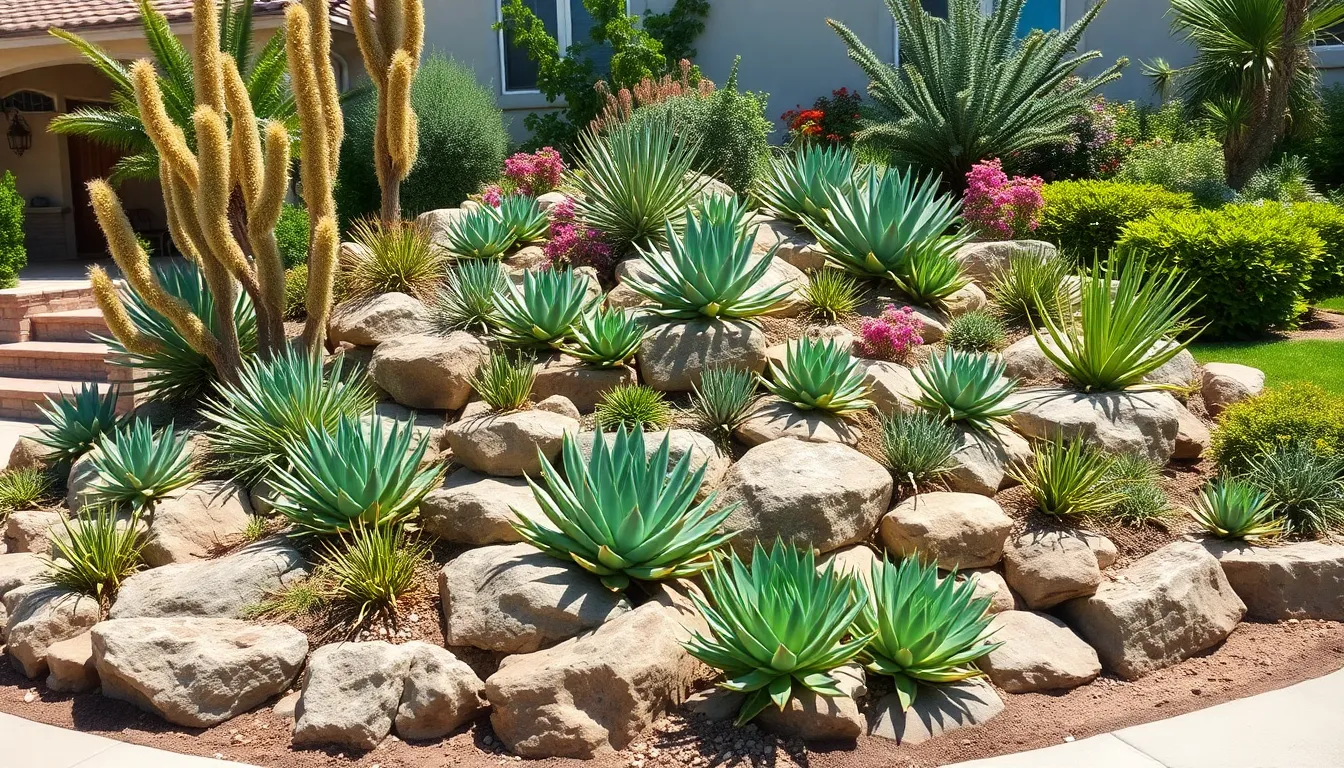
Creating vertical interest in your front yard transforms flat succulent displays into ever-changing landscapes that captivate from every angle. Tiered rock gardens provide the structural foundation needed to showcase your succulents while solving practical drainage challenges.
Layer Different Heights with Natural Stone
Natural stone creates the perfect framework for building multi-level succulent displays that draw the eye upward. We recommend positioning taller specimens like Yucca rostrata at the highest tier to establish dramatic focal points. Medium-height agaves work beautifully in the middle sections, creating visual bridges between levels.
Lower-growing succulents like jade plants fill the bottom tiers perfectly, completing the cascading effect. This layering technique allows each plant to receive optimal sunlight while preventing taller varieties from overshadowing smaller ones. Repeating similar colors and forms across different heights builds continuity throughout the design.
Stone selection plays a crucial role in achieving natural-looking results. Choose rocks that complement your home’s architecture and existing industry features. Limestone, sandstone, and decomposed granite work exceptionally well with succulent color palettes, creating harmonious compositions that feel intentional rather than random.
Incorporate Drainage Answers for Plant Health
Proper drainage forms the foundation of every successful tiered succulent garden since these plants cannot tolerate waterlogged conditions. We always amend heavy clay soils with pumice or coarse sand before constructing our tiered systems. This prevents water from pooling around sensitive root systems.
Mounded soil creates natural drainage while adding sculptural elements to your design. Build each tier slightly higher than the surrounding grade to encourage water runoff. The elevated positioning helps prevent root rot, which remains the leading cause of succulent failure in home gardens.
Installing gravel drainage layers beneath each planting area provides additional protection against moisture buildup. We typically use a 4-inch base of crushed stone topped with industry fabric before adding amended planting soil. This system ensures excess water moves away from roots quickly, even during heavy rainfall periods.
Consider the natural slope of your yard when planning tier placement. Position the highest tiers where water naturally flows away from your home’s foundation. This approach protects both your plants and your property while creating visually appealing elevation changes that enhance curb appeal.
Establish Low-Maintenance Ground Cover Displays
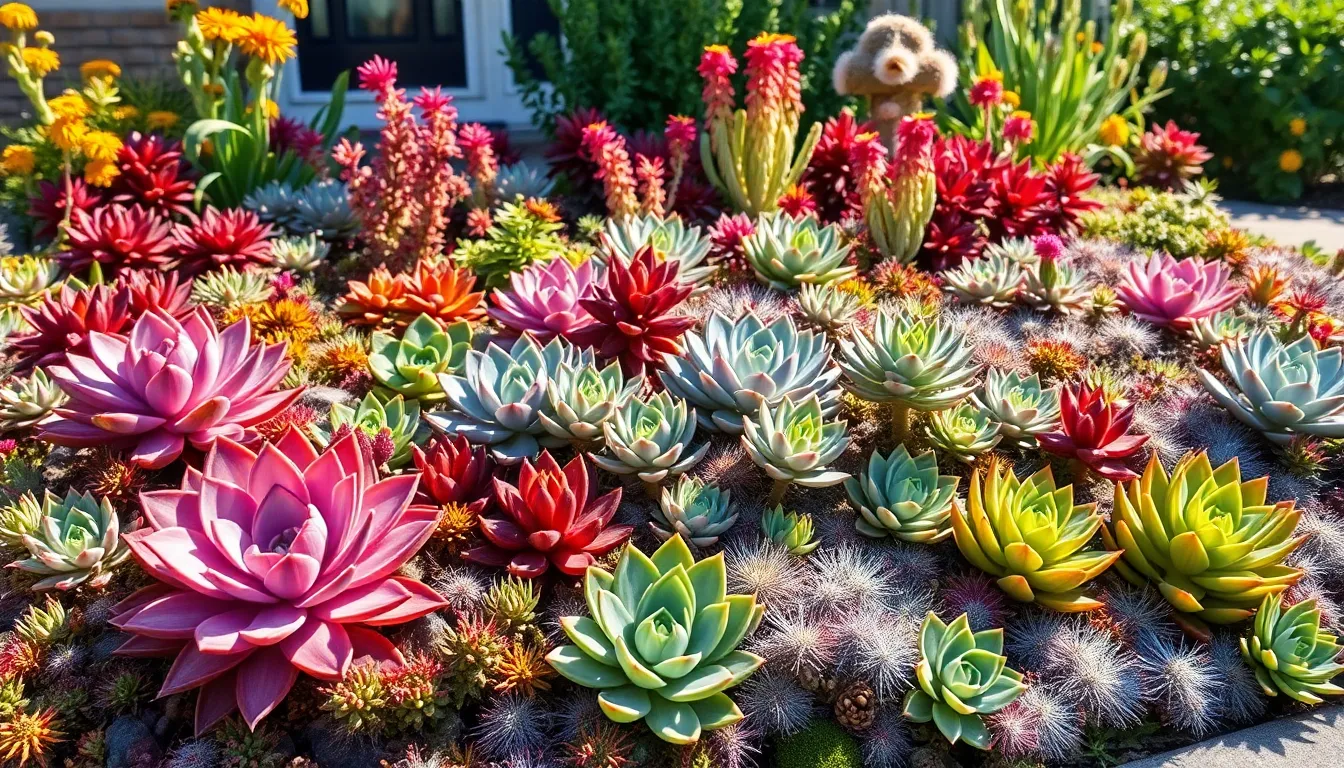
Transform your front yard into a water-wise industry by replacing traditional lawns with succulent ground cover displays. These drought-tolerant alternatives dramatically reduce watering and mowing requirements while creating visually striking, weed-resistant surfaces.
Use Spreading Succulents for Full Coverage
Spreading succulents naturally extend outward to fill gaps and create uniform coverage across your front yard terrain. Creeping Jenny cascades beautifully over rock edges and fills spaces between larger plants with its trailing stems. Trailing jade offers thick, fleshy leaves that spread horizontally to form dense mats perfect for slope stabilization.
Echeveria species provide excellent spreading coverage while maintaining their signature rosette formations throughout the growing season. Plant these varieties on berms or mounds to enhance drainage and add sculptural interest to flat landscapes. Sedums create lush, carpet-like displays that thrive in dry conditions and require minimal intervention once established.
Consider the natural growth patterns of each spreading variety when planning your layout. Position faster-spreading types like ice plants in areas where you want quick coverage, while using slower-growing options for more controlled expansion zones.
Combine Complementary Colors and Textures
Design your ground cover display by pairing plants with varied colors and textures to create layered visual richness. Green agaves complement yuccas beautifully, as both feature starburst shapes and architectural forms that enhance each other’s natural beauty. Repeat these color combinations throughout your design to establish visual continuity and professional polish.
Textural contrasts add depth and interest to ground-level plantings when viewed from multiple distances. Fuzzy kangaroo paw flowers provide soft, tactile elements that balance the smooth surfaces of jade plants and barrel cacti. Shimmering yuccas catch sunlight throughout the day, creating ever-changing visual effects that change with lighting conditions.
Create multidimensional color palettes by incorporating succulents with seasonal interest and year-round appeal. Blue-toned agaves pair naturally with warm-colored sedums, while silvery echeverias complement deep purple varieties for sophisticated contrast. Layer different heights within your ground cover to ensure each plant’s unique characteristics remain visible and contribute to the overall composition.
Install Vertical Succulent Walls as Living Art
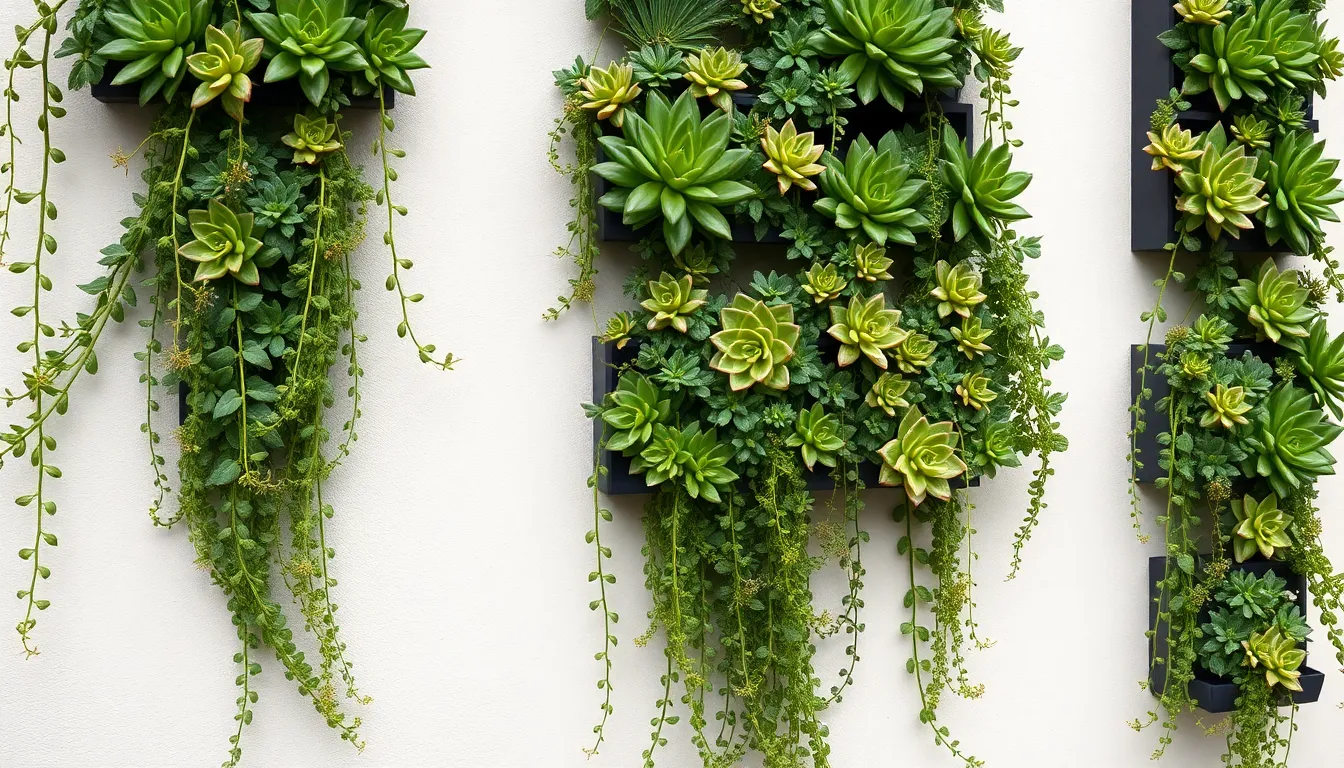
We’re transforming bare walls into stunning focal points that rival any traditional garden centerpiece. These living artworks maximize space while creating dramatic visual impact that enhances curb appeal year-round.
Mount Modular Planting Systems
Modular planting systems offer the perfect solution for creating maintenance-friendly vertical displays. We recommend choosing systems that allow easy replacement and rotation of individual succulents without disturbing the entire arrangement.
Wall-mounted units work exceptionally well for areas with limited ground space, transforming unused vertical surfaces into thriving gardens. Freestanding modular systems provide flexibility for renters or those who prefer portable options that can move with seasonal changes.
Installation becomes straightforward when we select lightweight materials that won’t strain wall supports. Most modular systems feature individual pockets or compartments that hold soil and plants securely while allowing proper drainage to prevent root rot.
Maintenance stays minimal with these systems since we can easily access each plant compartment for watering, pruning, or replacement. Strategic placement at eye level ensures the best visual impact while keeping plants within comfortable reach for care.
Choose Trailing Varieties for Cascading Effects
Trailing succulents create breathtaking cascading displays that add movement and dimension to vertical walls. String of Pearls produces delicate pearl-like leaves that drape gracefully from elevated containers, creating an elegant waterfall effect.
Burro’s Tail offers thick, rope-like stems covered in plump blue-green leaves that can cascade several feet when mature. These specimens work particularly well in upper tiers of vertical arrangements where their trailing nature becomes most pronounced.
Positioning these varieties strategically allows their natural growth patterns to enhance the overall design composition. We place trailing specimens in top and middle sections of vertical displays, letting gravity create natural sculptural forms that soften rigid wall structures.
Ever-changing visual appeal develops as these plants mature and extend their trailing stems over time. Different trailing varieties can be combined to create layered cascading effects with varying textures, colors, and growth rates that maintain interest throughout the seasons.
Arrange Container Gardens for Flexible Design
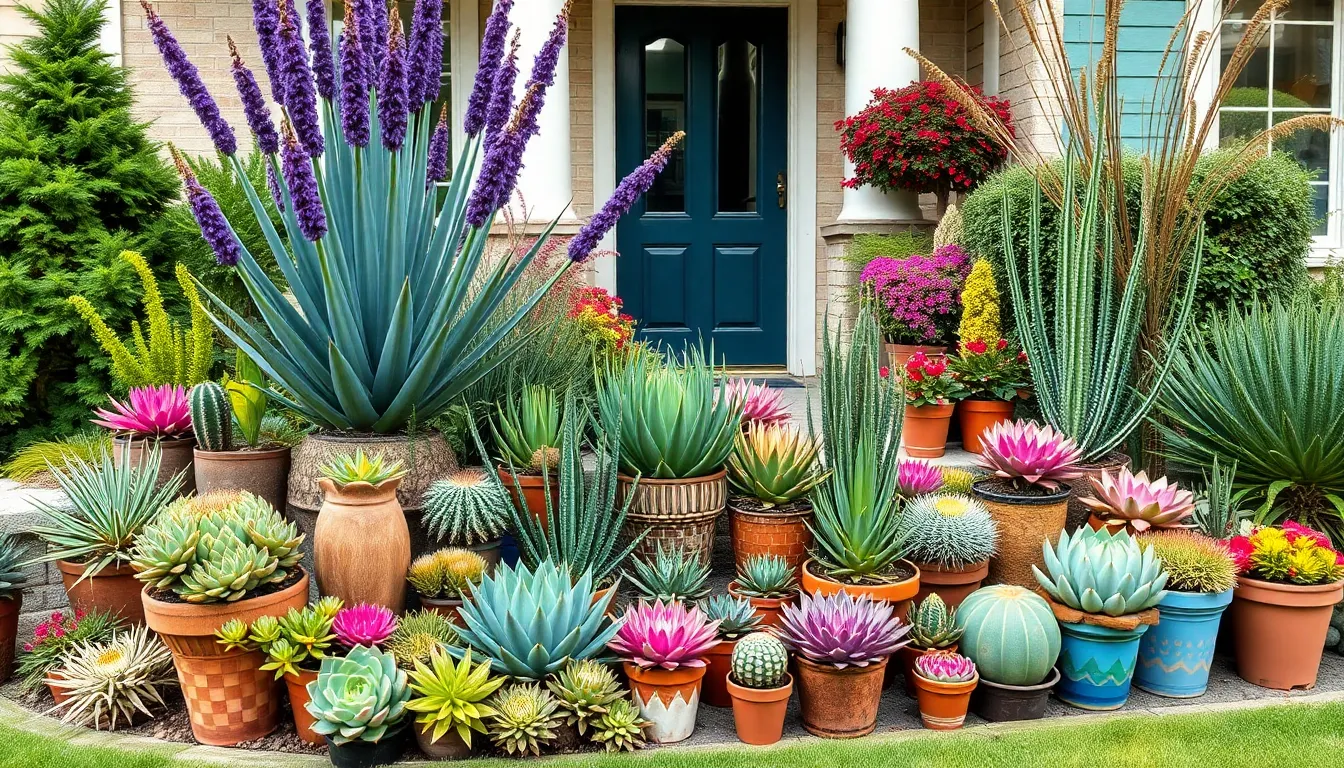
Container gardens offer unmatched versatility for front yard succulent displays. We can easily adjust layouts and accommodate plant growth by moving pots to create different visual effects throughout the seasons.
Group Different Sized Planters Strategically
Strategic grouping of planters creates visual balance and continuity in our succulent gardens. Clustering different sized containers helps establish ever-changing compositions that draw the eye naturally across the industry.
Large containers with dramatic succulents like Yucca rostrata serve as stunning focal points when positioned next to medium and small planters. We recommend placing these impressive specimens as anchor points, then surrounding them with textured or colorful succulents in smaller vessels.
Medium sized planters bridge the gap between statement pieces and delicate accents. Barrel cacti and architectural agaves work beautifully in these containers, providing structural interest without overwhelming smaller plants nearby.
Small containers add intricate details and allow us to showcase miniature varieties like rosette forming echeveria or trailing sedums. Grouping multiple small pots creates visual weight that balances larger specimens effectively.
Textural contrasts enhance the overall composition when we pair rough surfaced barrel cacti beside smooth leaved jade plants. This interplay of textures adds dimension and keeps viewers engaged with the display.
Repetition of plant forms or colors throughout grouped containers unifies the garden design. We can repeat exact succulent varieties or color schemes across different sized planters to create rhythm and flow.
Mix Seasonal Colors with Permanent Fixtures
Integrating seasonal color accents with permanent structural plants ensures year round visual interest in our container gardens. Permanent fixtures like agaves, yuccas, and other architectural succulents provide the stable backbone our designs need.
Structural succulents maintain their impressive forms throughout all seasons, giving us reliable focal points. These plants establish the foundation while seasonal additions bring ever-changing color changes that keep our gardens fresh and captivating.
Seasonal plants with red or pink hues create vibrant contrasts against the greens and blues of permanent specimens. We can easily swap out colorful succulents as seasons change, maintaining excitement without redesigning the entire layout.
Colorful varieties like red tipped jade plants or pink flowering kalanchoe add warmth during cooler months. These seasonal accents complement the cooler tones of permanent blue agaves and silvery echeveria beautifully.
Swapping seasonal containers allows us to refresh our displays without disturbing established plantings. This flexibility means we can experiment with new color combinations while keeping our favorite permanent specimens in place.
Ever-changing seasonal changes ensure our gardens never look static or boring. We maintain visual appeal through changing seasons by carefully balancing permanent structure with flexible seasonal elements.
Incorporate Decorative Mulch and Gravel Pathways
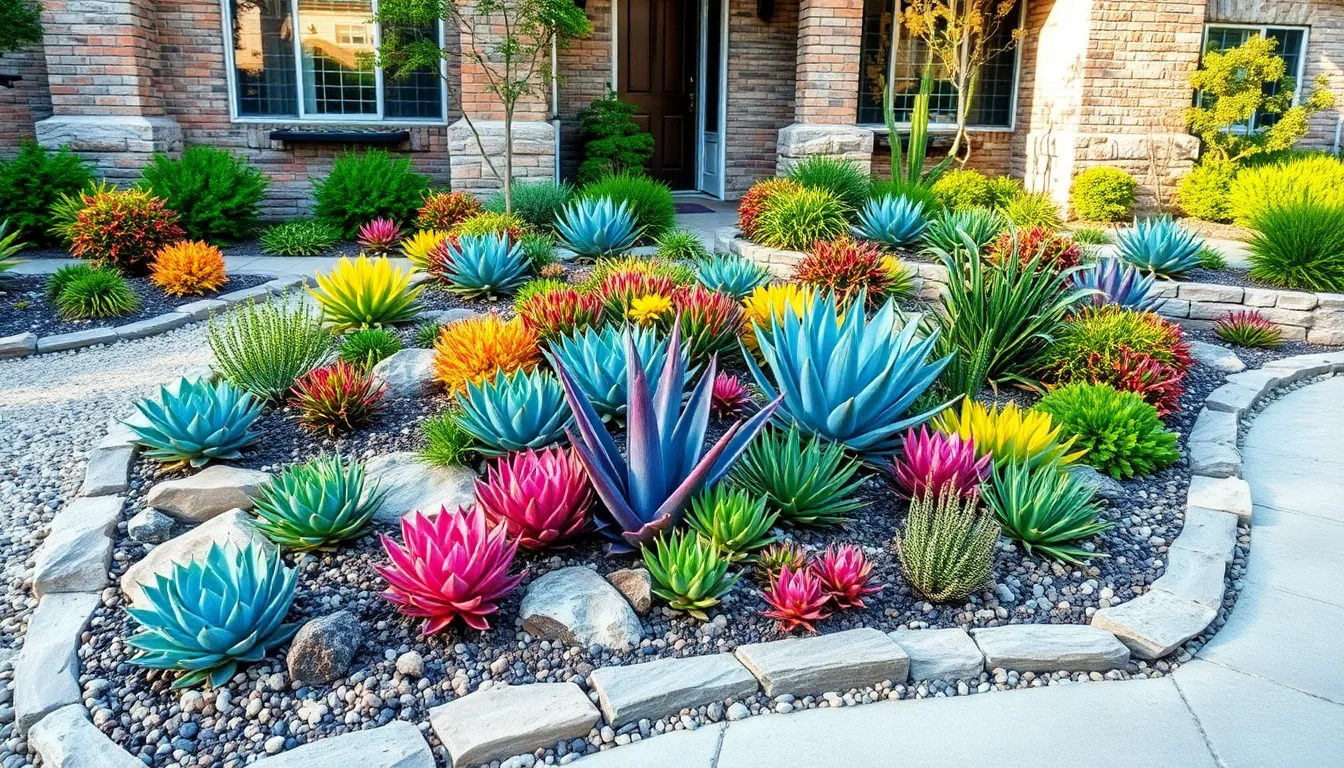
Building on our foundation of structural succulent displays, decorative pathways create seamless transitions between planting areas while improving drainage. These hardscape elements complement our living installations by providing practical walkways and visual contrast against colorful succulent foliage.
Select Complementary Stone Colors and Sizes
Choosing stones that harmonize with succulent hues creates visual cohesion throughout our front yard design. Beige and gray stones work exceptionally well because they complement various succulent colors and textures without competing for attention. We can achieve stunning results by matching cool-toned stones with blue-green agaves and warm earth tones with golden barrel cacti.
Stone size variation adds depth and professional polish to our pathways. Large stones serve as decorative anchors at pathway intersections or garden corners, creating natural stopping points for the eye. Medium-sized gravel fills the main walking surfaces while providing excellent drainage for nearby plantings. Small crushed stone works perfectly for filling gaps between larger pavers and creating clean borders around succulent beds.
We should consider using decomposed granite as our base material since it compacts well and provides stable footing. This creates a solid foundation that prevents shifting while maintaining the natural appearance that complements our drought-resistant plantings.
Create Definition Between Planting Areas
Clear boundaries between different garden zones help organize our succulent displays while guiding visitor movement through the space. Stone borders offer the most durable solution for separating pathway areas from planting beds, using materials like natural fieldstone or recycled concrete blocks. These permanent barriers prevent gravel migration while creating clean lines that enhance our garden’s professional appearance.
Elevated planting beds add vertical dimension to our front yard while improving drainage conditions for our succulents. Building berms or raised areas using soil amendments creates natural-looking mounds that showcase taller specimens like yucca plants against shorter ground covers. This elevation technique also helps direct water away from plant crowns, preventing the root rot issues that plague many succulent gardens.
Designated plant zones organize our collections by grouping similar species or complementary colors together. We can create distinct sections for architectural agaves, colorful echeveria displays, and trailing varieties, making maintenance easier while showcasing each plant’s unique characteristics. This zoning approach also allows us to adjust watering schedules and soil conditions to match exact plant requirements within each defined area.
Add Lighting to Highlight Nighttime Garden Beauty
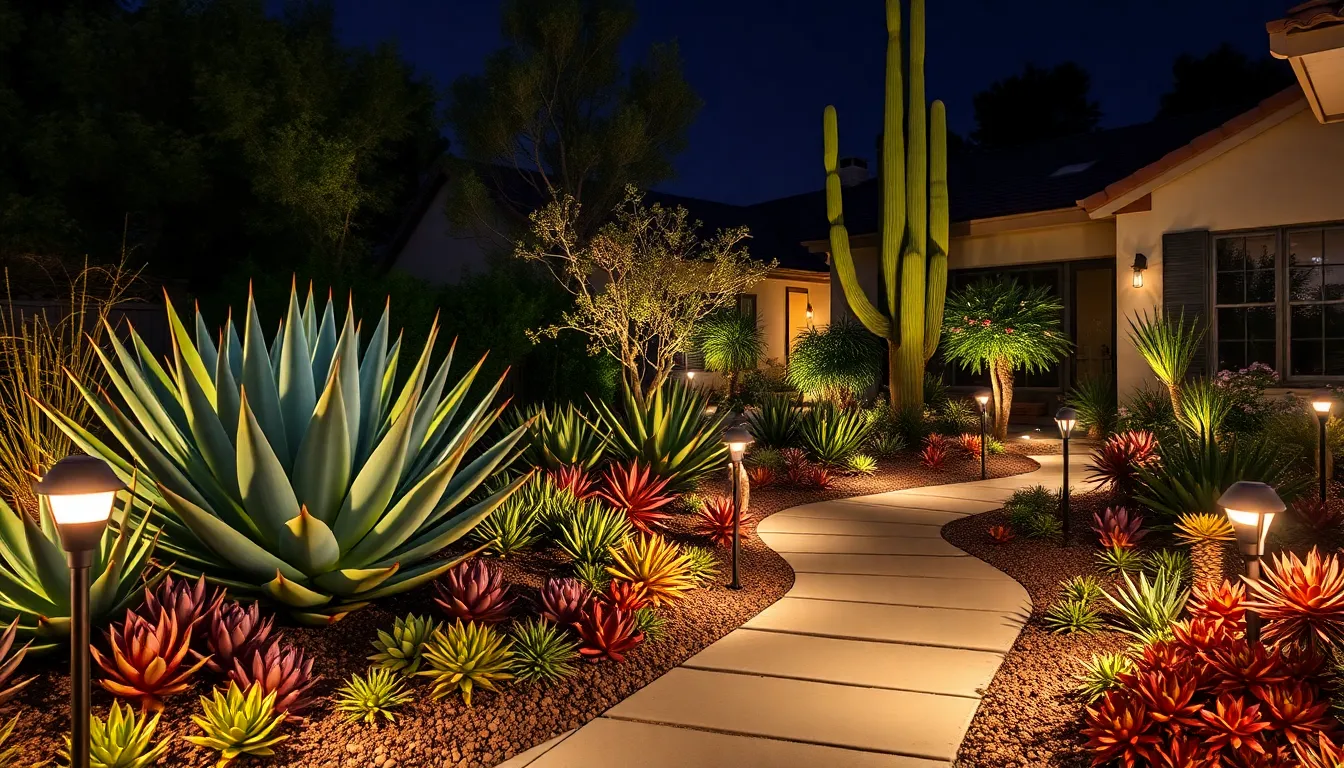
Extending our succulent garden enjoyment beyond daylight hours transforms the space into a captivating evening industry. Strategic lighting showcases the unique textures and forms that make these plants so compelling while adding essential safety features to our front yard design.
Install Solar Spotlights on Key Specimens
Solar spotlights create dramatic focal points by illuminating our most striking succulent specimens. Large agaves, sculptural yuccas, and unique architectural forms become stunning nighttime features when properly lit from below or at angles that emphasize their distinctive silhouettes.
Position solar powered spotlights to cast shadows that highlight the textural qualities of our chosen plants. Century plants and blue agaves transform into living sculptures when strategic lighting reveals their sharp edges and geometric patterns. These energy efficient fixtures require no electrical wiring and automatically activate at dusk.
Adjust spotlight angles to create depth and visual interest throughout our garden display. Barrel cacti and queen victoria agaves benefit from side lighting that accentuates their symmetrical forms and surface textures. Multiple spotlights on larger specimens prevent flat lighting while ensuring even illumination of complex plant structures.
Consider grouping smaller succulents near illuminated focal points to create cohesive lighting zones. Echeveria rosettes and jade plants gain prominence when positioned within the gentle spillover light from our main spotlights. This approach maintains visual hierarchy while showcasing supporting plants in our overall design.
Use Path Lighting for Safety and Ambiance
Path lighting ensures safe navigation through our succulent garden while creating warm, inviting ambiance for evening enjoyment. Low voltage or solar path lights guide visitors along walkways while providing subtle illumination that doesn’t overpower our plant displays.
Install path lights at regular intervals along curved walkways to maintain consistent visibility and rhythm. Strategic placement every 6 to 8 feet creates adequate lighting coverage without creating harsh bright spots. This spacing allows our colorful Echeveria borders and trailing Sedum varieties to remain visible during nighttime hours.
Choose warm light temperatures that complement the natural colors of our succulent plantings. Soft yellow or amber tones enhance the purple hues of ‘Black Prince’ Echeveria and the silvery tones of ‘Perle von Nurnberg’ varieties. Cool white lights can wash out these subtle color variations that make our garden distinctive.
Position path lights to illuminate stepping stones and grade changes in our tiered rock gardens. Proper lighting prevents accidents while showcasing the sculptural terrain we’ve created with mounds and valleys. Integrated lighting reveals our garden’s layout and allows full appreciation of our carefully planned plant arrangements after dark.
Combine Succulents with Native Drought-Resistant Plants
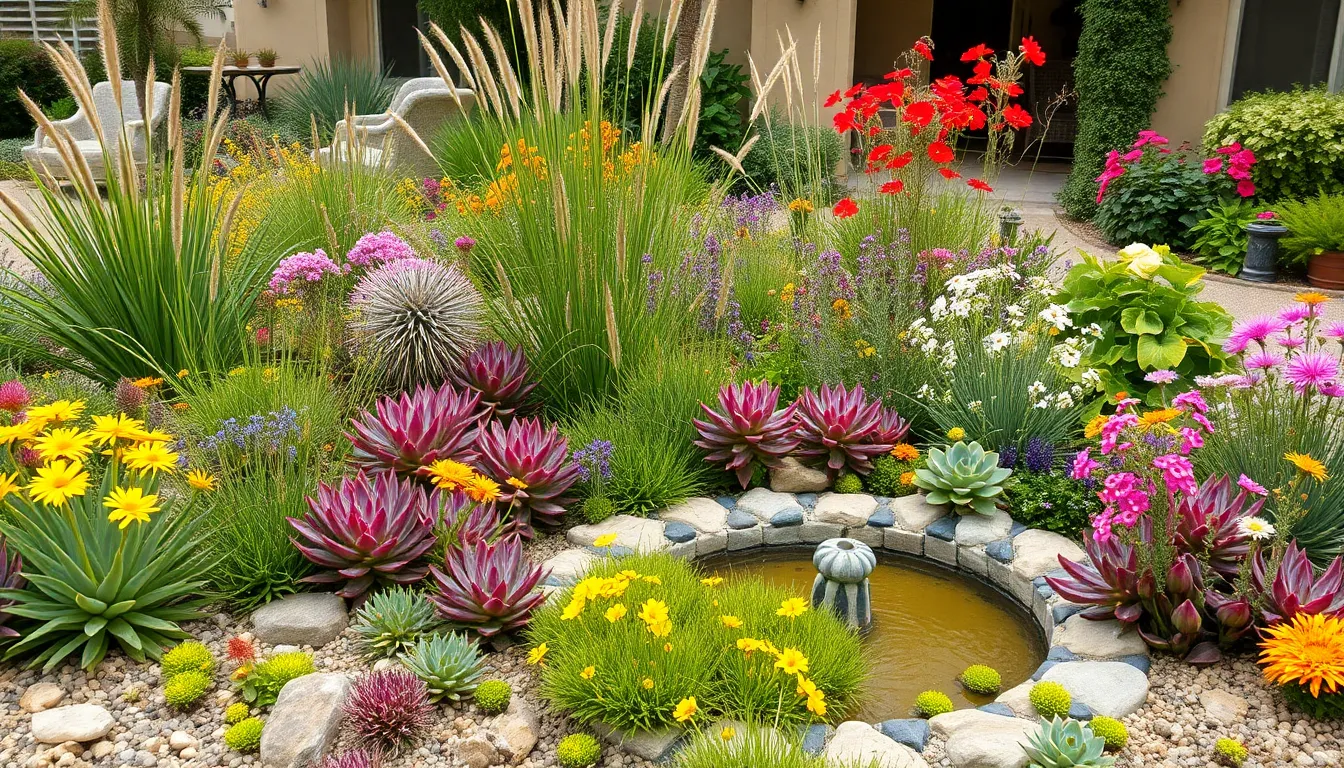
Building on your established succulent foundation, we’ll enhance biodiversity while maintaining the water-wise principles that make these gardens so sustainable.
Pair with Ornamental Grasses and Wildflowers
Ornamental grasses create stunning textural contrasts against structured succulent forms while maintaining drought tolerance throughout the season. Blue oat grass provides silvery blue foliage that complements the architectural shapes of agaves and yuccas, while pampas grass adds dramatic height and flowing movement to larger garden spaces.
We recommend positioning these grasses strategically around your existing succulent displays to soften harsh edges and create natural transitions between planted areas. Feather reed grass works exceptionally well as a backdrop for medium-height succulents, providing vertical interest without overwhelming smaller specimens.
Wildflowers bring seasonal color bursts that change throughout the year, offering ever-changing visual interest alongside your permanent succulent plantings. Native varieties like desert marigold and blanket flower attract beneficial pollinators while requiring minimal additional water beyond your established irrigation schedule.
Consider creating flowing drifts of ornamental grasses that weave between succulent clusters, establishing rhythm and continuity across your front yard industry. This layered approach adds depth while maintaining the low-maintenance characteristics that drew you to succulent gardening initially.
Create Habitat for Local Wildlife
Wildlife-friendly plantings transform your succulent garden into a thriving network that supports local biodiversity while maintaining its striking visual appeal. Succulent flowers naturally attract bees and butterflies, particularly when agave and yucca blooms appear in their dramatic seasonal displays.
We suggest incorporating native wildflowers that bloom at different times throughout the year, ensuring continuous nectar sources for visiting pollinators. Desert lupine and penstemon varieties provide essential resources while complementing the color palette of your existing succulent arrangements.
Strategic placement of these wildlife-attracting plants creates observation opportunities from indoor living spaces, allowing you to enjoy the increased bird and butterfly activity your garden will generate. Position flowering plants near seating areas or prominent windows to maximize viewing pleasure.
Native plants require less water than non-native alternatives, supporting the drought-resistant principles that make succulent gardens so practical. This approach reduces maintenance requirements while creating a more sustainable industry that benefits both your household and local wildlife populations.
Small water features like shallow dishes or decorative fountains provide drinking opportunities for birds while adding gentle sound elements to your outdoor space. These additions enhance the habitat value without compromising the clean, modern aesthetic that succulent gardens provide.
Design Themed Gardens with Specific Succulent Families
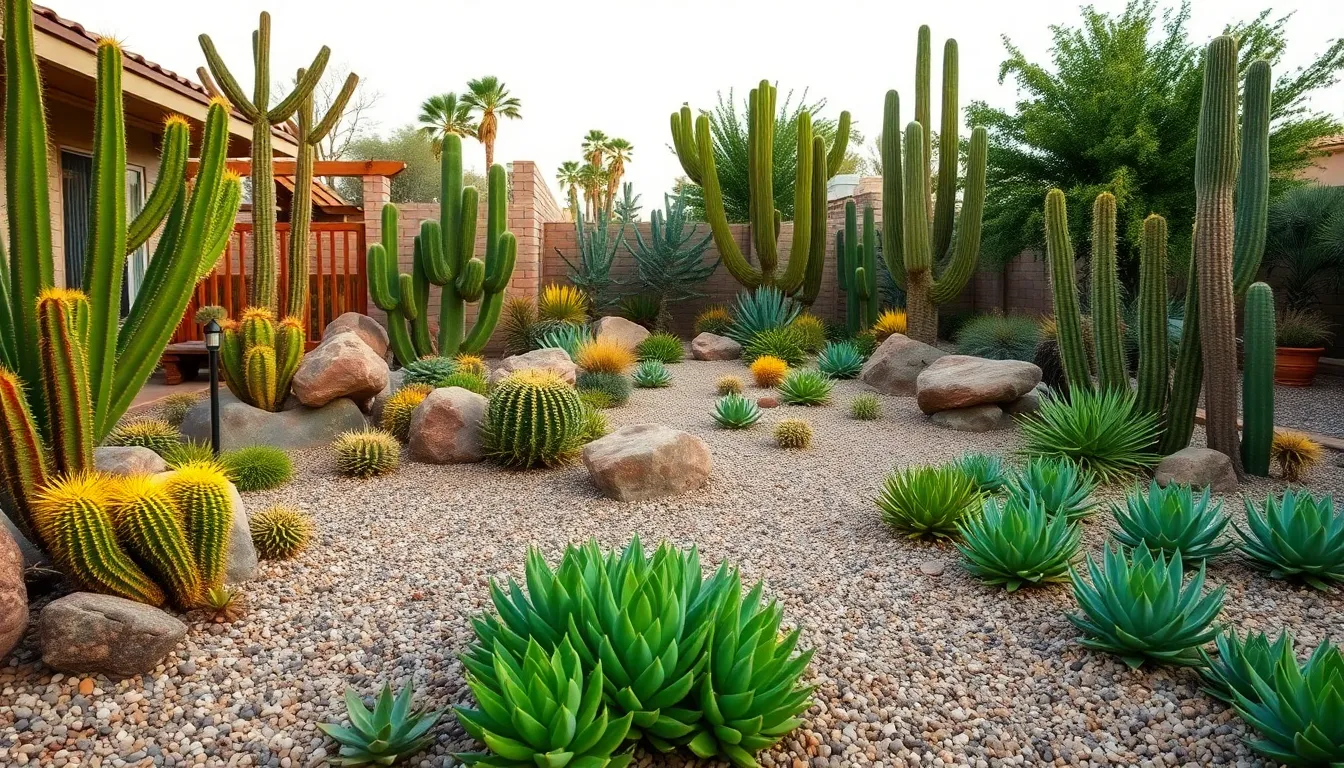
Creating cohesive succulent displays becomes effortless when we focus on exact plant families that share similar characteristics and care requirements. Themed approaches allow us to showcase the unique beauty of each succulent type while maintaining visual harmony throughout our front yard design.
Create Cactus-Only Desert Landscapes
Cactus gardens transform our front yards into striking desert landscapes that require minimal water and maintenance. Barrel cacti serve as perfect centerpieces with their distinctive round shapes and dramatic presence, creating visual anchors that draw the eye throughout the garden. Columnar varieties like organ pipe and saguaro cacti add vertical interest and establish strong architectural lines against horizontal planes.
We can arrange different cactus species in clusters based on their mature sizes, placing taller specimens toward the back and shorter varieties in front for optimal visibility. Prickly pear cacti offer wide, flat pads that create interesting geometric patterns, while cholla cacti contribute delicate branching structures that catch morning and evening light beautifully.
Desert landscaping with cacti works particularly well in arid climates where these plants naturally thrive. Gravel mulch and decomposed granite pathways complement the desert aesthetic while providing excellent drainage that prevents root rot. Strategic placement of boulders and weathered wood accents enhances the natural desert feel without overwhelming the plant displays.
Develop Jade Plant Meditation Spaces
Jade plants create serene meditation areas with their calming green foliage and peaceful energy that promotes relaxation and mindfulness. These succulent trees develop substantial trunks over time, establishing living sculptures that anchor quiet contemplation spaces within our front yard design. Mounding jade varieties spread naturally to form soft, flowing borders that define meditation zones without creating harsh barriers.
We can sculpt terrain with gentle berms and shallow valleys to create intimate spaces that feel separate from busy street activity. Jade plants respond well to pruning, allowing us to shape them into bonsai-like forms that enhance the zen atmosphere of meditation gardens. Their thick, fleshy leaves catch and reflect light beautifully during golden hour, creating shifting patterns of light and shadow.
Curved pathways lined with jade plants guide visitors through the meditation space while maintaining the peaceful flow of energy. Combining different jade varieties adds subtle textural interest without disrupting the calming monochromatic green palette. Strategic placement of smooth river rocks and weathered stone creates natural seating areas where we can pause and appreciate the tranquil beauty of these resilient plants.
Conclusion
Creating your dream front yard succulent garden doesn’t have to be overwhelming. We’ve shown you how these versatile plants can transform any space into a stunning water-wise industry that’ll make your neighbors envious.
Whether you’re drawn to dramatic agave centerpieces or prefer the charm of jade plant meditation spaces your succulent garden will deliver year-round beauty with minimal effort. The key is starting with one design element that speaks to you then building from there.
Your front yard deserves to be both beautiful and sustainable. With proper planning and the right succulent combinations you’ll create an outdoor space that enhances your home’s curb appeal while supporting local wildlife and conserving water.
Now it’s time to grab your gardening gloves and start planting. Your low-maintenance succulent paradise awaits!
Frequently Asked Questions
What are the main benefits of using succulents in front yard landscaping?
Succulents offer exceptional drought resistance, requiring minimal water and maintenance compared to traditional landscaping. They provide year-round visual interest with unique textures, colors, and architectural forms. These versatile plants can transform ordinary spaces into stunning, water-wise landscapes while significantly reducing upkeep costs and time investment.
Which agave varieties work best as focal points in desert-themed front yards?
The century plant offers impressive size and dramatic presence, while blue agave provides striking silvery-blue coloration. Queen Victoria agave brings elegant symmetry with distinctive white markings, and artichoke agave features perfect geometric patterns. Each variety serves as a low-maintenance centerpiece that requires minimal water while delivering maximum visual impact.
How can I create effective succulent pathway borders?
Use colorful Echeveria varieties like ‘Black Prince’ and ‘Perle von Nurnberg’ for stunning rosette formations. Combine these with Sedum species such as trailing ‘Burrito’ and spreading ‘Dragon’s Blood’ for contrasting textures. Mix cool-toned and warm-toned varieties to maintain visual interest throughout seasons while guiding visitors along curved, flowing pathways.
What’s the best approach for designing tiered rock gardens with succulents?
Create multi-level arrangements using natural stone, placing taller specimens like Yucca rostrata on the highest tier. Position medium-height agaves in the middle section and lower-growing plants like jade at the bottom. This layering optimizes sunlight exposure, prevents overshadowing, and creates dramatic vertical interest while ensuring proper drainage.
Can succulents effectively replace traditional lawn grass?
Yes, spreading succulents like Creeping Jenny and trailing jade create uniform ground coverage that eliminates mowing and reduces watering needs by up to 80%. Echeveria and Sedum species form lush, carpet-like displays that thrive in dry conditions while providing year-round color and texture variation.
How do I create successful vertical succulent walls?
Use modular planting systems for easy maintenance and individual plant replacement. Incorporate trailing varieties like String of Pearls and Burro’s Tail to create cascading effects. Position plants strategically to utilize their natural growth patterns, ensuring proper drainage and adequate light exposure for healthy vertical displays.
What container garden strategies work best for front yard succulent displays?
Group different-sized planters strategically, using large containers with dramatic specimens like Yucca rostrata as focal points. Medium planters bridge gaps between statement pieces and accents, while small containers showcase intricate details. This approach allows flexible design adjustments and easy seasonal plant swapping for continuous visual interest.
How can I enhance my succulent garden’s nighttime appeal?
Install solar spotlights on key specimens to create dramatic focal points and showcase unique textures. Use path lighting for safety and ambiance along walkways. Choose warm light temperatures and position lights strategically to transform larger agaves and yuccas into living sculptures after dark.
Should I combine succulents with other drought-resistant plants?
Yes, pairing succulents with native plants like ornamental grasses and wildflowers enhances biodiversity while maintaining water-wise principles. Blue oat grass and pampas grass create textural contrasts, while desert marigold and blanket flower add seasonal color and attract pollinators, supporting local wildlife habitat.
What maintenance advantages do succulent gardens offer over traditional landscaping?
Succulent gardens require 70-80% less water than traditional landscapes and need minimal fertilization or pest control. They’re naturally pest-resistant, require infrequent pruning, and many varieties are frost-tolerant. This translates to significantly lower maintenance costs, reduced time investment, and sustainable gardening practices that benefit both homeowners and the environment.

